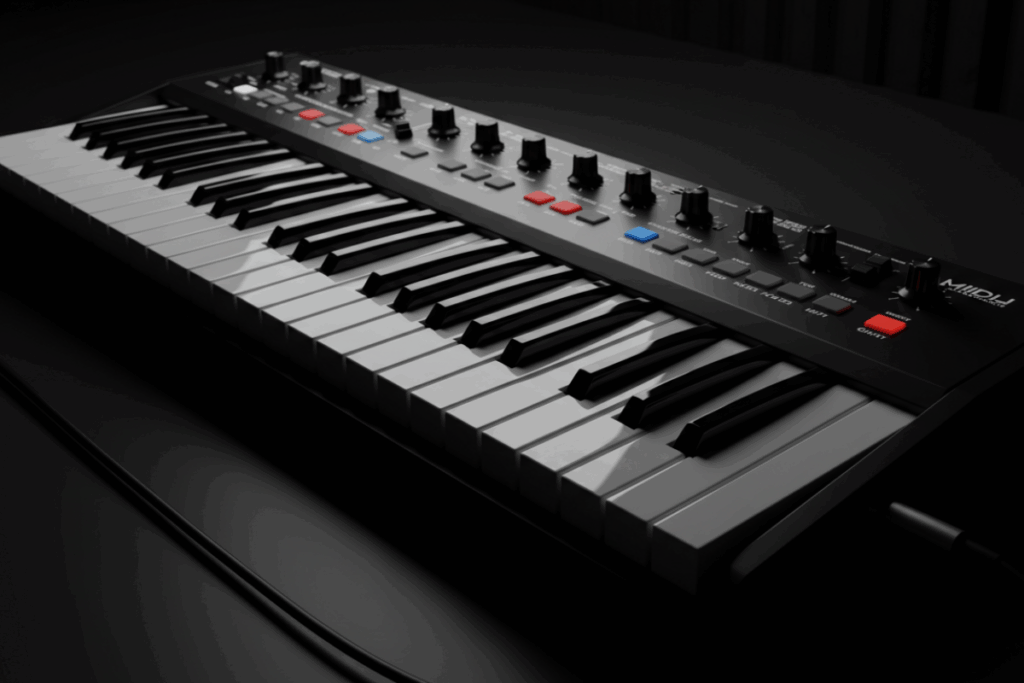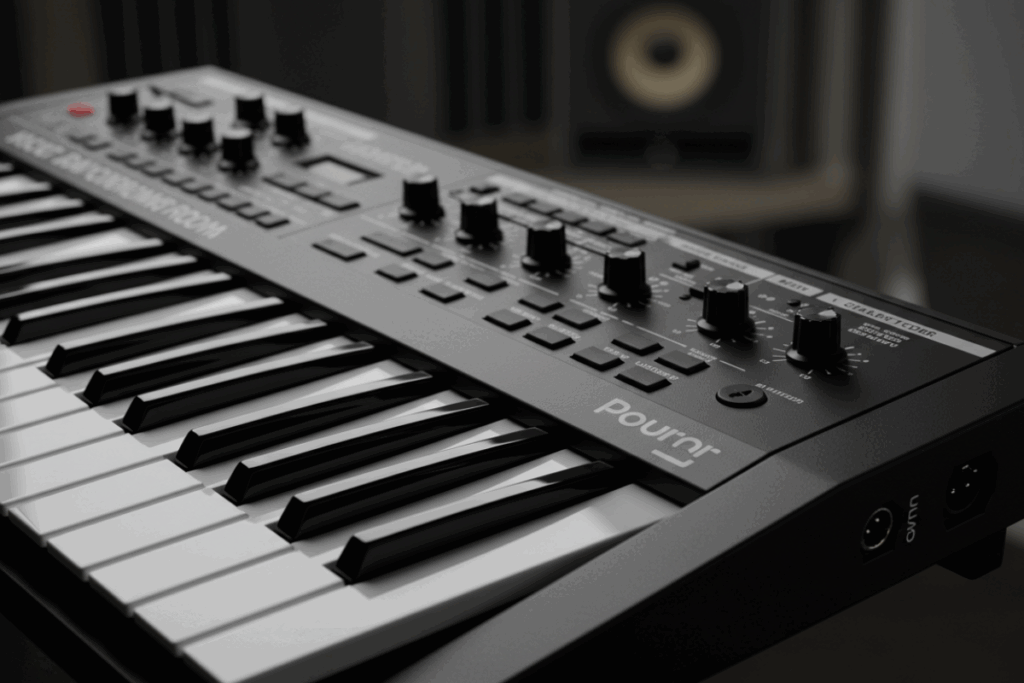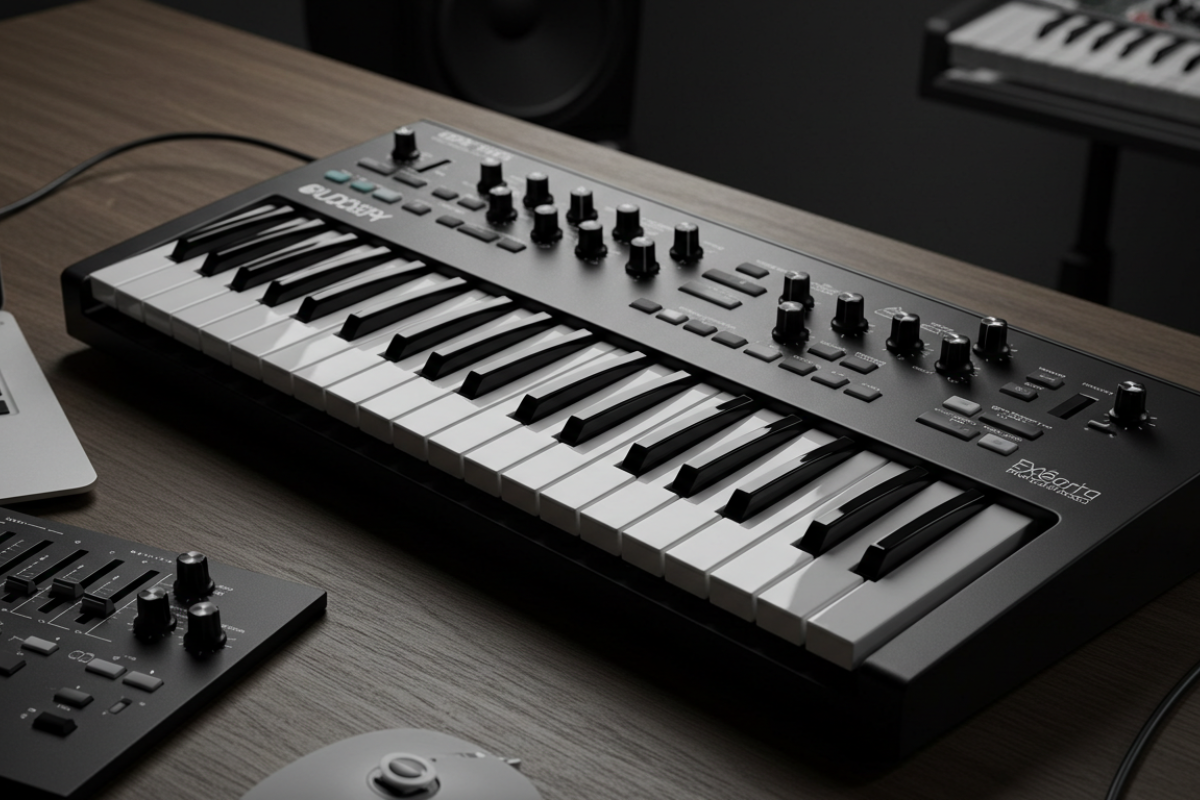Portable keyboards for musicians looking for MIDI connectivity are my go-to tools when I need flexible control and real creativity on the road or in the studio. At Keyboards Technology I explain why MIDI matters, how I use it to control virtual instruments and my DAW, and how I sync hardware synths and drum machines.
I cover MIDI messages, channels, and timing in plain terms, compare USB, 5‑pin DIN, and Bluetooth, and explain when I choose a USB MIDI portable keyboard for studio work or a travel‑friendly unit with DIN or Bluetooth for gigs. I also share the adapters and hubs I trust, how I weigh key count and action, and the latency and driver checks I run before a session.
Key Takeaway
- I choose models from Keyboards Technology for robust USB‑MIDI, Bluetooth LE, and DIN MIDI options.
- Pick compact to full‑size keybeds to match travel and studio needs.
- Prioritize low latency and class‑compliant drivers for plug‑and‑play performance.
- Assignable knobs, pads, and pedal inputs are essential for live control.
- Slim, durable builds and flexible power options win for gigging and travel.
Why MIDI connectivity matters
I love how MIDI turns a small keyboard into a giant studio. With MIDI I can play a piano, a huge pad, or tight drum loops from one board — saving time and keeping ideas alive. I rely on portable keyboards for musicians looking for MIDI connectivity because they fit my workflow and let me move fast. MIDI gives me flexibility, control, and a clean signal path for recording or performing.
How I use MIDI to control virtual instruments and my DAW
I plug the keyboard into my laptop, select the track in the DAW, and play. The sound comes from a plugin while I perform on the keyboard. I map the mod wheel to a filter cutoff, a knob to reverb send — shaping sound while I play.
In the studio I record MIDI, not audio. MIDI files are small and editable: move notes, fix timing, and change sounds without re‑recording. Live, program changes and MIDI mappings let me switch patches quickly.
How I use MIDI to sync hardware synths and drum machines
I send MIDI Clock from my DAW or keyboard to drum machines to lock tempo. Start/stop messages launch patterns; program changes recall patches. Sometimes the keyboard is the master clock; other times the drum machine leads. The key is one clock source to avoid tempo drift. MIDI sync turns scattered gear into one band.
Quick facts about MIDI messages, channels, and timing
| Topic | What I remember fast |
|---|---|
| Note On / Note Off | Tells synths when a key is pressed or released |
| Control Change (CC) | Knobs, wheels, pedals (e.g., CC1 = mod wheel) |
| Program Change | Switch patches or presets |
| Pitch Bend | Smooth pitch shifts |
| Channels | 16 channels per MIDI link |
| Timing | MIDI Clock = 24 pulses per quarter note; Start/Stop/Continue for transport |
Keep these facts pinned — they help fix stage problems fast.
How I choose between USB, 5‑pin DIN, and Bluetooth MIDI
Match the connection to the job. If you search for “Portable keyboards for musicians looking for MIDI connectivity,” this is how I sort the mess.
When I pick a USB MIDI portable keyboard for studio work
I reach for USB for rock‑solid timing and power over one cable. USB gives low latency, simple routing, and stable power — perfect for tracking.
| Need | Why USB fits |
|---|---|
| Low latency | USB is fast and steady |
| Power | Many keyboards get bus power via USB |
| Setup speed | One cable to computer |
| Software control | Easy with synth plugins and editors |
USB is my first pick for studio sessions.
When I need a travel‑friendly keyboard with DIN or a Bluetooth MIDI keyboard for performers
For travel and live gigs I think small and flexible. I use 5‑pin DIN to hook to legacy stage racks or vintage synths — it’s simple and reliable. I choose Bluetooth MIDI for cable‑free setups with phones/tablets, but I watch for dropouts and bring cables as backup.
| Factor | 5‑pin DIN | Bluetooth MIDI |
|---|---|---|
| Gear compatibility | Great for vintage gear | Great for modern phones/tablets |
| Reliability | Very reliable | Good, can glitch |
| Setup speed | Needs a cable | Fast, no cable |
| Power | No extra power | May need battery |

Practical adapters and hubs I trust
I carry a short list of adapters that solve most problems:
- USB‑C to USB‑A hub — use older USB keyboards with new laptops. Metal, bus‑powered hubs stay cool.
- Compact DIN‑to‑USB interface — connects vintage synths to a laptop; class‑compliant models work with macOS/Windows.
- Bluetooth MIDI adapter — plug‑and‑play dongle for older keyboards.
- Powered USB hub — when multiple devices need power and stable data flow.
- Camera/Lightning adapter — for iPad users who prefer wired MIDI.
| Scenario | Adapter |
|---|---|
| Vintage synth → laptop | DIN‑to‑USB interface |
| Keyboard → iPad | Camera Adapter / Lightning to USB |
| Multiple USB devices on stage | Powered USB hub |
| Go wireless quickly | Bluetooth MIDI adapter |
Label cables and keep spares — that habit has saved me more than once.
How I pick key count and action for travel and studio
I ask: what will I do with it, and where will I carry it? I focus on playability, portability, and MIDI needs. For me, portable keyboards for musicians looking for MIDI connectivity must be light, responsive, and reliable.
Why choose a 25‑key portable MIDI controller for travel
I grab a 25‑key when I want speed and low fuss. Fits a backpack; runs on USB power or battery.
- Small size = fast setup
- Octave shift keeps range usable
- Great for mobile DAWs and soft synths
- Limited for two‑hand voicings
| Feature | Why I like it |
|---|---|
| Size & weight | Very compact; fits travel bag |
| Power | USB/battery, no outlet needed |
| Range | Octave shifts cover melodies |
| Best use | Jamming, sketching, live pad control |
Why choose a 49‑key portable MIDI keyboard for more range
I pick a 49‑key when I need real playing space for chords and bass lines — still travel‑friendly.
- More keys = two‑hand playing
- Better for performance and arranging
- Often offers semi‑weighted or synth action
- Slightly heavier but portable
| Feature | Why I like it |
|---|---|
| Range | Chords, lines, and bass |
| Playability | Comfortable for longer sessions |
| Controls | More knobs/faders for DAW work |
| Best use | Studio tracking, small gigs |
Trade‑offs I use to balance portability and playability
- Value speed & light load → 25‑key
- Value comfort & range → 49‑key
- Prefer semi‑weighted for studio, synth‑action for travel
- Choose units with solid MIDI ports and USB power
- More knobs/sliders = fewer mouse clicks
Features I test: controllers, pedals, sounds, and power
I check knobs, pads, pitch/mod, MIDI and sustain
Turn every knob, press every pad. Controls must be responsive and not loose. Test pitch and mod wheels for smooth travel and no jitter. Link a synth over MIDI and confirm latency and mapping. Test the sustain input with your favorite pedal — it should latch cleanly with no noise.
| Control | What I check | Why it matters |
|---|---|---|
| Knobs | Smooth rotation | Live sound tweaking |
| Pads | Velocity, bounce | Reliable beats and cues |
| Pitch/Mod | Smooth travel | Musical expression |
| MIDI | Immediate response | Works with rigs and DAW |
| Sustain | Clean on/off | Real piano feel |
USB bus power vs battery power
Weigh convenience vs freedom. USB is simple; batteries free you from outlets but add weight and may dim features.
| Power Type | Pros | Cons |
|---|---|---|
| USB bus power | Simple, no charging | Needs a host or adapter |
| Battery power | Works anywhere | Adds weight; runtime varies |
Check real runtime — specs can be optimistic. Many small keyboards draw 100–500 mA; if a model needs more, it may require an adapter.
Minimum feature list I require before I buy
- MIDI over USB and hardware MIDI ports if needed
- Sustain input that is silent and reliable
- Responsive keys in your preferred action (synth, semi‑weighted, hammer)
- Precise pitch & mod controls
- Power options: USB bus power or decent battery life
- Clear mapping to DAWs and synths with minimal menus
- Solid build for travel and gigs
- Good factory sounds or clean MIDI output to modules
If a model misses these marks, I move on.
Form factors for gigging, travel, and home studio
I choose reliability and ease. That’s why I reach for portable keyboards for musicians looking for MIDI connectivity that match stage, suitcase, or bedroom needs.
Why a lightweight MIDI controller works on stage
Lightweight controllers cut setup stress and reduce fatigue. Modern lightweight units still offer touch strips, pads, and knobs for live tweaking.
| Feature | Why I care |
|---|---|
| Weight | Less fatigue, quicker setup |
| Size | Fits on standard stands |
| Controls | Pads/encoders for live tweaks |
| Build | Solid casing prevents slips |
Why I pack a compact MIDI controller for travel or busking
Compact controllers fit in backpacks, often run on USB/battery, and connect to phones or laptops fast.
- Small footprint for travel bags
- Battery option for busking
- MIDI over USB for fast connections
Travel tips: padded sleeve, short USB cable, battery or bus‑powered unit.
How I protect and carry my keyboard for safe travel
Checklist:
- Use a padded gig bag for local travel
- Choose a hard case for airline travel
- Wrap cables in a pouch; label gear and cables
- Remove loose items and pack separately
- Add a foam strip under keys for shock protection
| Scenario | Carry option | Why |
|---|---|---|
| Local gig, car | Padded gig bag | Easy grab-and-go |
| Busking, bike | Backpack sleeve | Hands‑free |
| Air travel | Hard flight case | Maximum protection |
How I integrate a portable MIDI keyboard with my DAW and mobile devices
Mapping controls with a USB MIDI portable keyboard
Plug the USB cable into your laptop and choose the keyboard as the MIDI input. Use your DAW’s MIDI Learn: move a control, click the parameter, and save the mapping as a template.
Common mappings:
| Controller | DAW parameter |
|---|---|
| Mod wheel (CC1) | Cutoff / Mod depth |
| CC7 (Volume) | Track fader |
| CC10 (Pan) | Stereo pan |
| CC11 (Expression) | Layer level |
| Sustain (CC64) | Sustain pedal |
Assign transport controls (Play/Stop/Record) to pads to keep hands on the keys.

Pairing a Bluetooth MIDI keyboard with iPad/phone
Put the keyboard in Bluetooth mode, ensure a good charge, open Bluetooth settings on your device, and tap the keyboard. Some apps list BLE MIDI devices in their MIDI settings — connect there if needed.
If pairing fails, try: toggle Bluetooth, restart the app, move devices closer, and close other Bluetooth devices.
| Feature | USB | Bluetooth |
|---|---|---|
| Power | Bus-powered | Battery-powered |
| Latency | Very low | Slightly higher |
| Setup | Driver or auto-detect | Pairing step |
| Portability | Less | More |
| Best for | Studio tracking | Live or mobile use |
For live gigs, always run a short soundcheck and bring a backup cable.
Latency, driver, and compatibility checks I run before a session
Do these five‑minute checks:
| Check | What I do | Why |
|---|---|---|
| Firmware/Driver | Update firmware and install drivers if required | Fix bugs, add compatibility |
| MIDI Channel | Confirm keyboard and DAW channel match | Prevent stray notes |
| Buffer Size | Set audio buffer low for tracking | Reduce latency |
| Test Note | Play and record a short phrase | Verify timing and sound |
| Bluetooth Interference | Turn off nearby unused devices | Reduce dropouts |
| Power | Full battery or USB power | Avoid mid‑session shutdown |
| App Connection | Confirm app shows keyboard | Avoid surprise disconnects |
If latency appears, adjust buffer. For Bluetooth, move other wireless gear away. Install drivers before the session when required.
Conclusion
A portable keyboard with solid MIDI options is my Swiss Army knife. Whether tracking in the studio or busking on a train, I reach for gear that delivers low latency, reliable USB (or 5‑pin DIN) when it counts, and clean Bluetooth for quick setups. Models that emphasize playability, portable MIDI connectivity, and solid build quality win every time.
Match the connection to the job, pack the right case, and keep a short checklist — those habits keep the music flowing and the stress low. If you want hands‑on suggestions or model picks for portable keyboards for musicians looking for MIDI connectivity, check the gear guides at Keyboards Technology and try the models that meet the minimum feature list above.
Frequently Asked Questions
Q: What should I look for when choosing portable keyboards for musicians looking for MIDI connectivity?
A: Look for USB‑MIDI, 5‑pin DIN, Bluetooth, assignable controls, and class‑compliant behavior. Prioritize build and key feel.
Q: How do I connect a portable keyboard to my phone or computer?
A: Use USB (with OTG adapter if needed) or pair via Bluetooth MIDI. For iPad, Camera/Lightning adapters work well for wired MIDI.
Q: Is Bluetooth MIDI reliable enough for live shows?
A: Bluetooth is great for quick setups and mobile use, but for critical gigs I prefer wired USB or 5‑pin DIN with a cable backup.
Q: Do I need drivers or are these keyboards class‑compliant?
A: Class‑compliant models need no drivers; check specs before buying. Drivers may be required for advanced features.
Q: Which MIDI features matter most for performers and producers?
A: MIDI In/Out/Thru, program changes, assignable CCs, multi‑zone, and pedal inputs are the most useful features for live and studio work.

